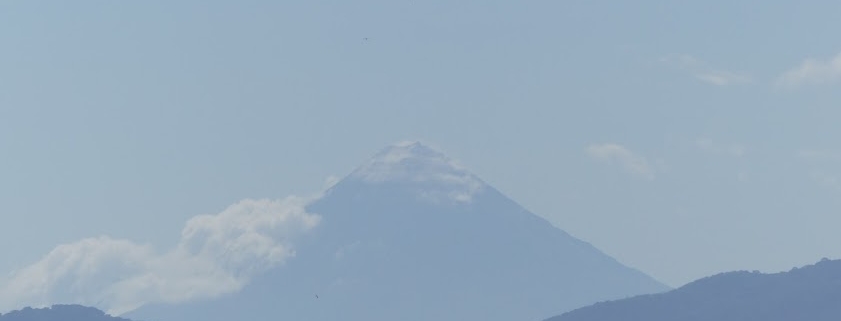February Birding in Nicaragua
Article and all photos by FMN Robin Duska
Reprinted with permission from Northern Virginia Bird Club, originally published in The Siskin, April 2022
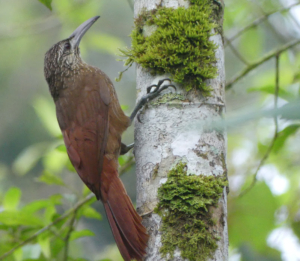
Strong-billed Woodcreeper
The prospect of birding near volcanos and in cloud forest drew me to Bill Volkert and Connie Ramthun’s February 2022 tour to Nicaragua. Likely because of its perennially fraught political climate and, despite its 750+ bird species, its lack of endemics, Nicaragua attracts few international birders. This was, however, the 16th trip for Bill and Connie, experienced and intrepid world travelers. Bill, an ornithologist and former naturalist at Wisconsin’s Horicon Marsh, and Connie, who ran a native plant nursery, live in Wisconsin’s northern Kettle-Moraine.
Birding in gardens at the Best Western Mercedes Hotel across from Managua Airport netted my first trip lifer, a Hoffman’s Woodpecker. We then set off to Volcan Masaya
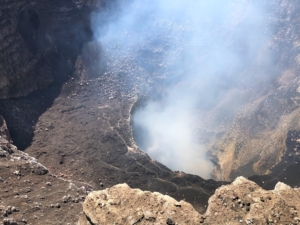
Masaya volcano
National Park and Visitor Center for an introduction to the geology of this volatile region where three tectonic plates converge. Peering down into the smoking, active Masaya volcano, we watched two Peregrine Falcons flying along its cliffs. Recommended human exposure to the sulphureous fumes? No more than 15 minutes.
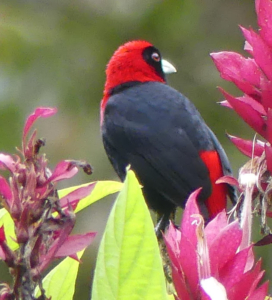
Crimson-collared Tanager
By midday, we were in the dry forest of Montibelli private reserve, home to 175 species including Turquoise-browed and Lesson’s Motmots and 10 species of hummingbirds. I wish I’d recorded the surprisingly loud wingbeats of Red-billed Pigeons passing overhead there and at the nearby Chocoyero-El Brujo reserve—the flocks sounded as loud as small aircraft.
We worked with local guides at each site on our trip but unfortunately we “dipped” on Nicaragua’s only near-endemic, the Nicaraguan Grackle (Quiscalus nicaraguensis), allegedly found along Lake Cochibola (Lake Nicaragua) and nearby Lake Managua. Our leaders had occasionally seen it on earlier trips.
From our next base in the attractive colonial city of Granada, we took a morning boat trip amid the 365 islands that were formed when nearby Mombacho volcano erupted around 20,000 years ago. Mangrove Swallows and my favorite Scissor-tailed Flycatchers dipped into the water as we motored around. Among the 39 species seen that morning were a Bare-throated Tiger Heron and amid hundreds of Montezuma Oropendola nests, an optimistic Giant Cowbird. Later, we stopped in San Juan de Oriente, home to potters for over 1000 years. The beautiful and inexpensive pottery features both pre-Colombian and modern designs.
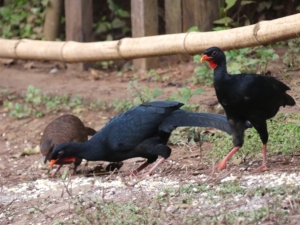
Highland Guan
Next we took the Pan-American Highway into the Matagalpa-Jinotega highlands, beautifully green even in the dry season. El Jaguar Reserve, run by eBird reviewer Liliana Chavarria-Duriaux and her husband, is home to 378 species. In the cloud forest surrounding Liliana’s coffee fields, vulnerable Highland Guan reliably amble out into view. We had fine sightings of three of my favorite trip species: Black-crested Coquette, Strong-billed Woodcreeper, and Slate-colored Solitaire with its ethereal calls.
I especially enjoyed a morning to the west of El Jaguar at Reserva Natural Cerros de Yali where the oak-pine forest, a vital wintering area for warblers including Grace’s and Golden-winged, reaches its southern boundary in Central America. To our delight, four very similar warblers—Townsend’s, Hermit, Golden-cheeked, and Black-throated Green—showed up within minutes of each other. Nearby, a pair of Red Crossbills, a wide-ranging species, fed placidly in a pine.
We went on to enjoy more cloud forest at Selva Negra (Black Forest), where we stayed in lovely green-roofed German-influenced chalets. A
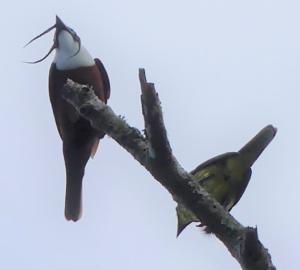
Three-wattled Bellbirds
Pale-billed Woodpecker, like other Campephilus woodpeckers including the extinct Ivory-billed, did its double-knock drumming out along a steep trail. I especially enjoyed watching male and female Three-wattled Bellbirds interact and listening to the male’s echoing call.
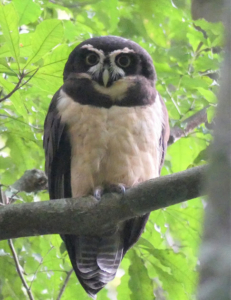
Spectacled Owl
Nicaragua’s handful of ornithologists participate in the Neotropical Flyways Project, monitoring and tagging birds for the Motus Wildlife Tracking System. Ecotourism provides valuable support in this vulnerable habitat, but travel now is complicated by the Nicaraguan government’s Covid testing documentation requirements and concerns about birding equipment. Four travelers from Bill and Connie’s two February tours were unable to enter the country, due to the former. After our leaders’ equipment was confiscated upon their arrival, they successfully negotiated for its return and for ours to be allowed in when the rest of us arrived on later flights. I therefore recommend birders not travel independently to the country at this time unless they have contacts in Nicaragua who can help them negotiate such possible impediments.
Despite the pre-arrival issues described, this was one of the more pleasant, well-paced, and satisfying birding trips I’ve taken. As the only non-Wisconsinite in our group, I also enjoyed learning from others who had far more hiking/hunting/farming/gardening experience than I do. Lodgings were comfortable and very clean.
Our group trip list was 211 species during 10 birding days. Bill and Connie plan to return to Nicaragua in 2024 and can be contacted via his website, which also links to Bill’s “Where To Watch Birds in Nicaragua” guide: http://www.billvolkert.com.


